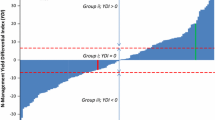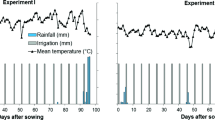Abstract
N2 fixation in lines of Phaseolus vulgaris was measured by 15N-isotope dilution to determine whether a programme of crossing and recurrent selection had resulted in enhanced nitrogen fixation. In field experiments on an isohyperthermic Aquic Hapludoll soil the amount of N2 fixed by the different lines ranged from 18 to 36 kg ha−1 (32 to 47% of plant N) in 56 days. The quantity of N2 fixed and the proportion of plant N derived from fixation was not significantly greater in the lines selected for N2 fixation (RIZ lines) than parental lines. Total shoot N ranged from 53 to 77 kg ha−1 and partitioning of N to pods differed from 28 to 52% among the lines which all had similar growth habit and duration. Nodulation patterns were also distinct. Nodules formed early (10 to 15 plant−1 at 13 days) in many lines, and smallest amounts of fixation were observed in those lines which nodulated slowly and did not form substantial nodule mass until after 40 days. The screening criteria used in the selection of the RIZ lines had been largely indirect with other factors such as disease resistance also being included. Progress for increasing N2 fixation over good-fixing parental lines such as BAT76 was not significant and it is recommended that more attention be paid to early nodulation, to the use of soils with lower available N and to inter-crossing of lines having different good N2 fixation traits in order to further enhance the potential for N2 fixation in beans.
Similar content being viewed by others
References
Barnes D K, Heichel G H, Vance C P and Ellis W R 1984 A multiple-trait breeding programme for improving the symbiosis for N2 fixation between Medicago sativa L. and Rhizobium meliloti. Plant and Soil 82, 303–314.
CIAT 1978 Annual Report of the Bean Production Programme 75p.
CIAT 1982 Annual Report of the Bean Production Programme. 234p.
CIAT 1983 Annual Report of the Bean Production Programme. 238p.
CIAT 1984 Annual Report of the Bean Production Programme. 311p.
CIAT 1990 Annual Report of the Bean Programme. 350p.
Conway E J 1939 Microdiffusion Analysis and Volumetric Error. Crosby-Lockwood, London.
Duque F F, Neves M C P, Franco A A, Victoria R L and Boddey R M 1985 The response of field grown Phaseolus vulgaris to Rhizobium inoculation and the quantification of N2 fixation using 15N. Plant and Soil 88, 333–343.
Giler K E and Witty J F 1987 Slow release fertilizers can improve the accuracy of field estimates of N2 fixation using 15N. Soil Biol. Biochem. 19, 459–463.
Graham P H 1981 Some problems of nodulation and symbiotic nitrogen fixation in Phaseolus vulgaris L.: A review. Field Crops Res. 4, 93–112.
Graham P H and Rosa J C 1977 Growth and development of indeterminate bush and climbing cultivars of Phaseolus vulgaris L. inoculated with Rhizobium J. Agric. Sci. Camb. 88, 503–508.
Graham P H and Temple S R 1984 Selection for improved nitrogen fixation in Glycine max (L.) Merr. and Phaseolus vulgaris L. Plant and Soil 82, 315–327.
Greder R R 1983 Heritabilities and associations of nodule mass and recovery of Bradyrhizobium japonicum strain 110 in soybeans. M. Sc. Thesis, University of Minnesota, St. Paul 43 p.
Kueneman E A, Root W R, Dashiell K E and Hohenberg J 1984 Breeding soybeans for the tropics capable of nodulating effectively with indigenous Rhizobium spp. Plant and Soil 82, 387–396.
McFerson J R 1983 Genetic breeding studies of dinitrogen fixation in common bean, Phaseolus vulgaris L. Ph.D. Thesis, University of Wisconson. 147 p.
McFerson J R, Bliss F A and Rosas J C 1982 Selection for enhanced nitrogen fixation in common beans, Phaseolus vulgaris. In Biological Nitrogen Fixation Technology for Tropical Agriculture. Eds. P HGraham and S CHarris. pp 39–44. CIAT, Cali.
Miller J C, Zary K W and Fernandez G C J 1986 Inheritance of N2 fixation efficiency in cowpea. Euphytica 35, 551–560.
Novozamsky I, vanEck R, vanSchouwenburg J C and Walinga I 1974 Total nitrogen determination in plant material by means of the indophenol-blue method. Neth. J. Agric. Sci. 22, 3–5.
Nutman P S 1984 Improving nitrogen fixation in legumes by plant breeding: The relevance of host selection experiments in red clover (Trifolium pratense L.) and subterranean clover (T. subterraneum L.). Plant and Soil 82, 285–301.
Rennie R J and Kemp G A 1983 N2 fixation in field beans quantified by 15N isotope dilution. II. Effect of cultivars of beans. Agron. J. 75, 645–649.
Rennie R J and Kemp G A 1984 15N-determined time course for N2 fixation in two cultivars of field bean. Agron. J. 76, 146–154.
Ruschel A P, Vose P B, Matsui E, Victoria R L and Tsai Saito S M 1982 Field evaluation of N2 fixation and N-utilization by Phaseolus bean varieties determined by 15N isotope dilution. Plant and Soil 65, 397–407.
St.Clair D A and Bliss F A 1991 Intrapopulation recombination for 15N-determined dinitrogen fixation ability in common bean. Plant Breeding 106, 215–225.
St.Clair D A, Wolyn D J, DuBois J, Burris R H and Bliss F A 1988 A field comparison of N2 fixation determined with 15N-depleted ammonium sulfate and 15N-enriched ammonium sulfate in selected inbred backcross lines of common bean. Crop Sci. 28, 773–778.
Witty J F 1983 Estimating N2 fixation in the field using 15N labelled fertilizer: Some problems and solutions. Soil Biol. Biochem. 15, 631–699.
Witty J F and Ritz K 1984 Slow release 15N fertilizer formulations to measure N2 fixation by isotope dilution. Soil Biol. Biochem. 16, 657–661.
Author information
Authors and Affiliations
Rights and permissions
About this article
Cite this article
Kipe-Nolt, J.A., Giller, K.E. A field evaluation using the 15N isotope dilution method of lines of Phaseolus vulgaris L. bred for increased nitrogen fixation. Plant Soil 152, 107–114 (1993). https://doi.org/10.1007/BF00016339
Issue Date:
DOI: https://doi.org/10.1007/BF00016339




